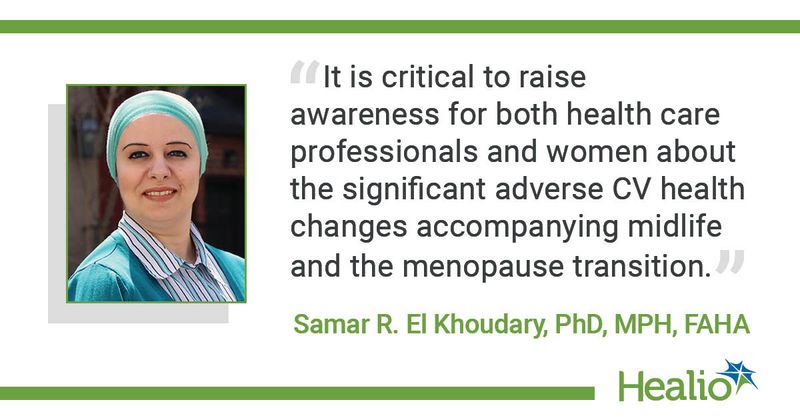Menopausal transition heralds elevated CV risk; early prevention is vital
Click Here to Manage Email Alerts
During the menopausal transition, women have an increased prevalence of cardiometabolic and CV risk factors; however, data on early preventive strategies are lacking, according to a new statement from the American Heart Association.
“We have accumulated data consistently pointing to the menopause transition as a time of change in CV health. Importantly, the latest AHA guidelines that are specific to women, which were published in 2011, did not include the data that is now available on menopause as a time of increased risk for women’s heart health,” Samar R. El Khoudary, PhD, MPH, FAHA, associate professor of epidemiology at the Epidemiology Data Center at the University of Pittsburgh, told Healio. “As such, there is a compelling need to discuss the implications of this accumulating body of literature on this topic.

“The reported findings underline the significance of the menopause transition as a time of accelerating CVD risk, thereby emphasizing the importance of monitoring women’s health during midlife, a critical window for implementing early intervention strategies to reduce CVD risk,” Khoudary said.
Heightened CV risk
Due to trends in overall life expectancy in the U.S., a significant proportion of women will spend up to 40% of their lives in postmenopause, according to the statement.
Occurrence of premature and early menopause is considered a marker of greater CVD risk, especially among Black or Hispanic women, in addition to:
- short menstrual cycle length;
- low parity;
- being a smoker;
- having a worse CV health profile during reproductive life; and
- undergoing iatrogenically induced menopause during the premenopausal period.
Hysterectomy, regardless of ovarian status, is not associated with CVD risk factors before or after menopause, according to the statement.
Vasomotor symptoms, depending on the timing of symptoms during the menopausal transition, in addition to sleep disturbance are both related to CVD risk among women.
Occurring more frequently during the perimenopausal and postmenopausal years, depression is also associated with vasomotor symptoms and incident CVD, according to the statement.
The perimenopause stage, which extends 12 months after menopause, is accompanied by significant alterations in several cardiometabolic and CV health parameters and is associated with increased CV risk.
During the menopausal transition, women may experience central and/or visceral fat increases and lean muscle decreases. Central adiposity is associated with increased risk for mortality, even with normal BMI. Additionally, paracardial fat volume increases after menopause and may be affected by estradiol levels or the use of menopausal hormone therapy.
Increases in LDL cholesterol and apolipoprotein B, metabolic syndrome risk and vascular remodeling at midlife are also driven by the menopausal transition.
Intervention strategies needed
“Knowing that women’s risk accelerates during the menopause transition could influence health care professionals to consider an aggressive, prevention-based approach for women during this stage in their lives to decrease the probability of a future CVD occurrence, such as heart attack or stroke,” Khoudary told Healio. “Irrespective of the accumulating findings showing adverse changes in multiple CV health parameters as women transition through menopause, we do not have data documenting current status of ideal CV health components during the menopause transition among women in the U.S. The limited data we have suggests that very small proportion of women transitioning through menopause eat a healthy diet (< 20%) or practice physical activity (approximately 7.2%) at a level that matches the current recommendations.”
According to the statement, a multidimensional lifestyle intervention during menopausal transition may prevent weight gain and lower triglycerides, BP, blood glucose, insulin and subclinical carotid atherosclerosis. However, randomized controlled trials that evaluate lifestyle and behavioral interventions have not adequately represented this population, the authors wrote.
The current literature supporting a role for the time of initiation of menopausal hormone therapy in relation to menopause, particularly because many who experience menopausal symptoms do so before reaching menopause, highlights the need for further research on its use: specifically, the impact of form, route and duration of therapy on cardiometabolic risk in women traversing menopause, according to the authors.
In addition, research on primary and secondary prevention of atherosclerotic CVD and improved lipid-lowering interventions in this population remains scarce.
“Lifestyle and behavioral interventions are critical to maintaining cardiovascular health and reduce heart disease. However, we do not have adequate randomized clinical trials testing these interventions specifically during the menopause transition,” statement writing committee vice chair Matthew A. Allison, MD, MPH, FAHA, professor and chief of the division of preventive medicine in the department of family medicine and public health at the University of California, San Diego, said in a press release. “Similarly, we need randomized clinical trials of therapeutic interventions, like cholesterol-lowering medications and menopause hormone therapy, in women who are transitioning through menopause. This at-risk population has not been the focus of previous clinical trials, thus leaving us with questions about how the results from these studies might apply to women during this earlier phase of menopause.”
Khoudary told Healio: “It is critical to raise awareness for both health care professionals and women about the significant adverse CV health changes accompanying midlife and the menopause transition and point out the importance of adopting prevention strategies early during this stage.”
For more information:
Samar R. El Khoudary, PhD, MPH, FAHA, can be reached at elkhoudarys@edc.pitt.edu.
